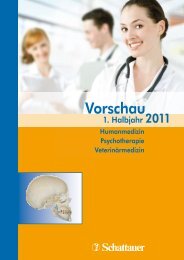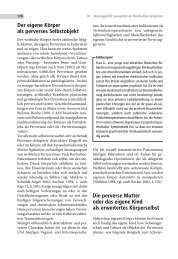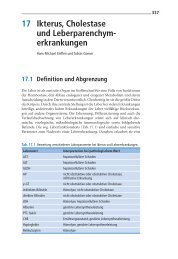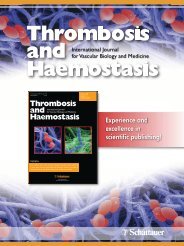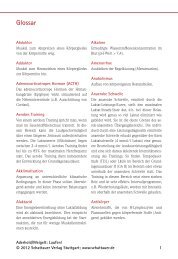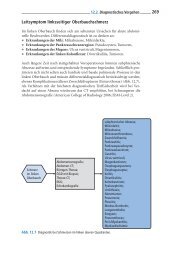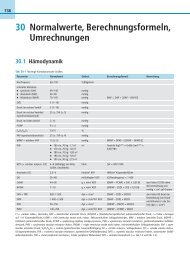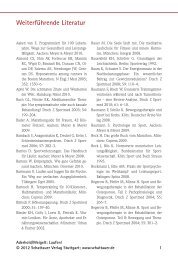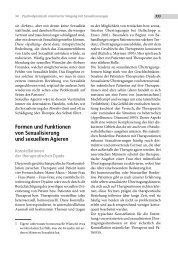DVO Guideline 2009 for Prevention, Diagnosis and Therapy of ...
DVO Guideline 2009 for Prevention, Diagnosis and Therapy of ...
DVO Guideline 2009 for Prevention, Diagnosis and Therapy of ...
Create successful ePaper yourself
Turn your PDF publications into a flip-book with our unique Google optimized e-Paper software.
66 <strong>DVO</strong> <strong>Guideline</strong> Osteoporosis <strong>2009</strong><br />
9.4.3 Components <strong>of</strong> biochemical<br />
assessment<br />
The following �table 2 shows the components<br />
<strong>of</strong> the biochemical analysis <strong>and</strong><br />
lists some <strong>of</strong> the most important differential<br />
diagnostic results to be assessed.<br />
A st<strong>and</strong>ard measurement <strong>of</strong> 25-hydroxy<br />
vitamin D <strong>and</strong> specific vitamin D supplementation<br />
as an alternative to a general vitamin<br />
D supplementation is presently not to<br />
be recommended due to the costs <strong>and</strong> the<br />
poorly st<strong>and</strong>ardised measurement methods<br />
with an inter-assay variability <strong>of</strong> up to 30 %.<br />
In individual cases, measurements can be<br />
taken into consideration be<strong>for</strong>e or during replacement<br />
treatment (e. g. <strong>for</strong> people living<br />
in old people’s homes with low sunlight exposure,<br />
women with veiled clothing, in case<br />
<strong>of</strong> a renal insufficiency or gastrointestinal<br />
diseases, or other causes <strong>of</strong> a major vitamin<br />
D insufficiency) (D) (E128).<br />
Men with osteoporosis <strong>of</strong>ten suffer from<br />
hypogonadism (B). The fracture rate <strong>for</strong><br />
men with hypogonadism is increased by<br />
1.5–2 times (A). Testosterone treatment<br />
leads to an increase in bone mineral density<br />
<strong>for</strong> these men (A). Due to this fact an<br />
assessment <strong>of</strong> testosterone is to be considered<br />
<strong>for</strong> men with increased fracture risk<br />
(B) (E126).<br />
Increased biochemical parameters <strong>of</strong><br />
bone turnover in blood <strong>and</strong>/or urine<br />
proved to be an independent risk factor <strong>for</strong><br />
fractures <strong>for</strong> men <strong>and</strong> women (B <strong>for</strong> men,<br />
A <strong>for</strong> women). Lack <strong>of</strong> st<strong>and</strong>ardisation <strong>of</strong><br />
these parameters in clinical every-day conditions<br />
<strong>and</strong> a lack <strong>of</strong> evaluation in connection<br />
with other risk factors do not allow at<br />
present a general recommendation <strong>for</strong> the<br />
use <strong>of</strong> routine diagnostics (D). In case <strong>of</strong> a<br />
bone turnover in the 1 st quartile, however,<br />
increasing the treatment threshold by half<br />
a T-score is justified in individual cases, although<br />
interactions with some other risk<br />
factors such as bone loss over time are unclear<br />
(E129) (D).<br />
Genetic examinations as an independent<br />
risk factor <strong>for</strong> fractures have not yet<br />
been sufficiently evaluated (D).<br />
Measurement <strong>of</strong> calcium excretion in<br />
24-hour urine may be useful <strong>for</strong> the diagnosis<br />
<strong>of</strong> idiopathic hypercalciuria (D).<br />
In case <strong>of</strong> aberrant biochemical<br />
measurements consultation <strong>of</strong> an expert<br />
should be considered <strong>for</strong> further diagnostics<br />
<strong>and</strong> treatment (D). Then the following recommendations<br />
<strong>for</strong> treatment are no longer<br />
valid in many cases or have to be modified.<br />
9.5 Other Medical Imaging<br />
Procedures, Bone Biopsy<br />
CT, MRI <strong>and</strong> scintigraphic examinations<br />
do not play a role in routine diagnostic assessment<br />
<strong>of</strong> osteoporosis (D). However,<br />
these methods are useful <strong>for</strong> certain questions<br />
in diagnostics <strong>and</strong> treatment (e. g.<br />
fracture age, stability <strong>of</strong> fracture <strong>and</strong> classification<br />
<strong>of</strong> pathological fractures).<br />
In addition to clinical <strong>and</strong> laboratory examinations,<br />
bone biopsy allows the diagnosis<br />
<strong>of</strong> rare secondary <strong>for</strong>ms <strong>of</strong> osteoporosis<br />
(e. g. mastocytosis, non-secretory<br />
multiple myeloma). Undecalcified bone<br />
biopsy also allows an exact assessment <strong>of</strong><br />
mineralization defects. Bone biopsies are<br />
not part <strong>of</strong> the primary diagnostics <strong>of</strong> osteoporosis,<br />
but may be considered in the<br />
case <strong>of</strong> non-plausible clinical <strong>and</strong>/or laboratory<br />
findings (D).<br />
10. Treatment<br />
10.1 Non-pharmacological<br />
Treatment<br />
10.1.1 Implementation <strong>of</strong> Lifestyle<br />
Measures <strong>for</strong> Fracture <strong>Prevention</strong>,<br />
Psychosocial Care<br />
Independent <strong>of</strong> a specific drug treatment,<br />
implementation <strong>of</strong> lifestyle measures <strong>for</strong><br />
fracture prevention is recommended <strong>for</strong> all<br />
persons at risk (A–D). Constraints which<br />
impede implementation <strong>of</strong> general preventive<br />
measures should be determined <strong>and</strong>, if<br />
possible, resolved.<br />
For patients with glucocorticoid treatment<br />
a sufficient, possibly intensified treatment<br />
<strong>of</strong> their underlying disease should be<br />
aimed at with optimal reduction in the disease<br />
activity, e. g. by additional use <strong>of</strong> immuno-suppressives<br />
such as methotrexate<br />
or azathioprine (if indicated). Thus glucocorticoid<br />
use should be reduced wherever<br />
possible or changed over to compounds<br />
with less influence on bone (D).<br />
For women treated with glitazones a<br />
change <strong>of</strong> treatment is recommended (D)<br />
(E59–61).<br />
Patients with falls <strong>and</strong> fractures are <strong>of</strong>ten<br />
afraid <strong>of</strong> further incidents. The vicious<br />
circle <strong>of</strong> further limitation <strong>of</strong> mobility by<br />
fear <strong>of</strong> falling <strong>and</strong> fractures may be<br />
counteracted by psychosocial care. To improve<br />
<strong>and</strong>/or maintain participation in<br />
daily life activities, practising the ability to<br />
function in individual areas <strong>of</strong> normal life<br />
can also contribute (D). Participation in<br />
self-help groups supported by experts is to<br />
be recommended (D).<br />
10.1.2 Calcium <strong>and</strong> Vitamin D<br />
A daily nutritional intake <strong>of</strong> 1000 mg calcium<br />
is sufficient (D). Calcium should only<br />
be supplemented if the recommended nutritional<br />
intake <strong>of</strong> calcium is insufficient<br />
(D). The total intake <strong>of</strong> nutritional calcium<br />
<strong>and</strong> supplements should not exceed<br />
1500 mg (D) (E97–106) (see 6.2).<br />
Serum 25-hydroxy vitamin D concentrations<br />



